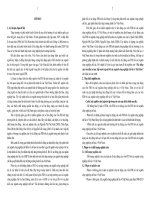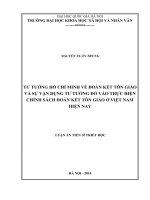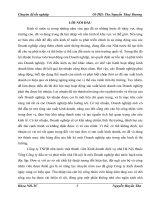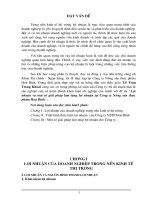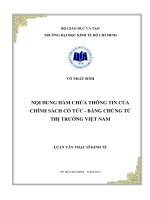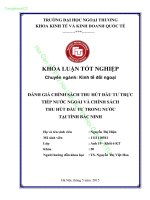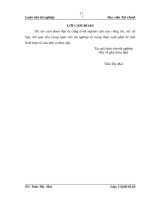Cảm tính nhà đầu tư, chất lượng lợi nhuận và chính sách cổ tức: Bằng chứng ở Việt Nam Tom tat_E
Bạn đang xem bản rút gọn của tài liệu. Xem và tải ngay bản đầy đủ của tài liệu tại đây (499.46 KB, 27 trang )
MINISTRY OF EDUCATION AND TRAINING
UNIVERSITY OF ECONOMICS HO CHI MINH CITY
--------------------
BUI KIM PHUONG
INVESTOR SENTIMENT, EARNINGS QUALITY AND
DIVIDEND POLICY: EVIDENCE FROM VIETNAM
SUMMARY OF PHD THESIS
Ho Chi Minh City – 2019
MINISTRY OF EDUCATION AND TRAINING
UNIVERSITY OF ECONOMICS HO CHI MINH CITY
--------------------
BUI KIM PHUONG
INVESTOR SENTIMENT, EARNINGS QUALITY AND
DIVIDEND POLICY: EVIDENCE FROM VIETNAM
Major: Finance – Banking
Major code: 9340201
SUMMARY OF PHD THESIS
SUPERVISOR:
Assoc. Prof. Dr. Nguyen Thi Ngoc Trang
Ho Chi Minh City – 2019
1
CHAPTER 1: INTRODUCTION
1.1
Introduction
The decision to pay dividends is one of the most important financial decisions in a firm. Therefore, the
investors and the policy makers always pay attention to this decision. There are many theories that have been
proposed to explain the dividend policy of the firm, such as the theory of tax, agency costs and signaling. In
addition, from the behavioral finance perspective, Baker and Wurgler (2004a) proposed the catering theory
of dividends based on investor sentiment. This theory was developed and tested by Baker and Wurgler
(2004a) with data from US listed firms. This theory is tested in other developed markets such as the United
Kingdom, Australia, European countries and OECD countries. In addition, a few studies that use data of
emerging markets such as Brazil, Thailand or Taiwan also investigate the effect of investor sentiment on
dividend policy. However, these studies have not reached a consensus on results in general. In recent years,
there are many studies that conducted in Vietnam on determinants of the firms’ dividend policy. Specifically,
these studies focus on analyzing the effect of profitability, firm size, growth, risk, financial leverage, firm life
cycle, and cash holdings on dividend policy. Do the firms pay dividends to cater to the preference of
investors when the Vietnamese market has many different features compared to developed markets? To
answer this question, the thesis studies the relationship between investor sentiment and dividend policy in
Vietnam with data of listed firms on HSX and HNX. Besides, the thesis continues to study whether
Vietnamese firms have the incentive to signal to investors about the earnings quality through dividend
payment policy. To clarify this issue, the thesis studies the relationship between earnings quality and
dividend policy in Vietnam.
1.2
Objectives
The thesis is conducted to explain the motivation for dividend payment of listed firms in Vietnam. To
achieve this general objective, the thesis aims at two specific objectives:
1.
Test the catering theory of dividends through investigating the relationship between investor
sentiment and the firms’ dividend payment policy.
2.
Study the effect of earnings quality on the firms’ dividend payment policy.
1.3
Research questions
To achieve the above research objectives, the thesis focuses on addressing the following two research
questions:
1.
Do firms make decisions to pay dividends to cater to the investors' preference?
2.
Do firms make decisions to pay dividends to signal about the earnings quality to investors?
1.4
Subject and scope of the study
In order to distribute earnings to shareholders, besides cash dividend, the firms can also buy back shares.
However, compared to cash dividends, share repurchases are less common. Therefore, the thesis only
focuses on cash dividend policy of the firms. Specifically, the thesis studies the dividend payment policy of
460 firms listed on HSX and HNX between 2010 and 2016. The data is collected from 2009 to 2017. The
2
data needed for research is extracted from the Datastream database. The final sample includes 2,653 firmyear observations.
1.5
Methodology
The thesis uses many different measures for both dependent and independent variables to ensure the
robustness and reliability of the research results. In addition, other factors that may affect the dividend policy
of the firms are also controlled. Besides, the thesis uses the system generalized method of moment to
estimate the relationship between investor sentiment and dividend policy as well as the relationship between
earnings quality and dividend policy. This method can help solve endogenous problems as well as other
defects of the research model.
1.6
Structure of the thesis
The thesis is structured into 5 chapters. Specifically, the introduction is presented in chapter 1. The next
chapter presents the theoretical framework and literature review. Methodology is clarified in chapter 3.
Chapter 4 presents and discusses research results. Finally, the conclusions and some policy implications are
presented in chapter 5.
CHAPTER 2: THEORETICAL FRAMEWORK AND LITERATURE REVIEW
2.1
DIVIDEND POLICY
John Lintner is considered to be the founder of the modern perspective on dividend policy. Specifically,
Lintner (1956) proposed the target payout hypothesis, which suggests that dividends are a function of longterm sustainable income. According to Lintner, dividend smoothing is common because managers believe
that the market places a premium on firms that have a stable dividend policy. Subsequent research by Miller
and Modigliani (1961) suggests that in perfect and efficient capital markets, dividend policy does not affect
the value of a firm. By relaxing some of the assumptions made by Miller and Modigliani models, four major
theories have been developed to explain the firm's dividend policy, including the theory of tax, signaling,
agency cost and behavior. In particular, the behaviorial theory on dividend preference of investors was
developed by Shefrin and Statman (1984) based on psychological reasons such as regret aversion, mental
accounting, prospect theory and self-control to explain why individual investors find dividends attractive.
From the ideas of Shefrin and Statman (1984), Baker and Wurgler (2004a) developed the catering theory of
dividends. According to this theory, firms choose payout policies to cater to investors' preference.
Specifically, when investor's preference for dividends declines, firms respond by not paying dividends and
vice versa.
2.2
INVESTOR SENTIMENT AND DIVIDEND POLICY
2.2.1
Investor sentiment
Investor sentiment is how investors formulate expectations about future earnings. Investors' decisions can be
affected by sentiment and betting against sentimental investors is costly and risky. Investor sentiment is not
easy to measure accurately. A number of measures have been proposed to measure investor sentiment,
including dividend premium. Based on dividend premium, Baker and Wurgler (2004a) developed the
catering theory of dividends. This theory will be presented in more detail below.
3
2.2.2
The relationship between investor sentiment and dividend policy
The catering theory of dividends was developed by Baker and Wurgler (2004a) that based on the ideas of
Shefrin and Statman (1984), whereby firms choose a dividend payment policy to cater to the preference of
the investors. In particular, firms cater to investors by paying dividends when investors place a share price
premium on firms that pay dividends. In contrast, firms will not pay dividends when investors prefer firms
that do not pay dividends. To measure the relative prices of firms that pay dividends and firms that do not
pay dividends, Baker and Wurgler (2004a) use dividend premium. It is the relative market valuation of
dividend payers versus dividend nonpayers. Many empirical studies support the catering theory of dividends,
such as those by Li and Lie (2006), Bulan et al. (2007), Kale et al. (2012), Liu and Chen. (2015), Ferris et al.
(2006), Lee (2010). However, a number of other studies find no evidence to support this theory (Julio and
Ikenberry, 2004; Hoberg and Prabhala, 2009; Li and Zhao, 2008; Renneboog and Trojanowski, 2011; Geiler
and Renneboog, 2015; von Eije and Megginson, 2008). In addition, an international study by Ferris et al.
(2009) and Kuo et al. (2013) find that firms in common law countries cater to the dividend preference of
investors while firms in civil law countries do not. Other studies in emerging markets such as Brazil,
Thailand and Taiwan show that firms cater to the dividend preference of investors (Boulton et al., 2012;
Tangjitprom, 2013; Wang et al. (2016).
2.3
EARNINGS QUALITY AND DIVIDEND POLICY
2.3.1
Earnings quality
The earnings quality is an indicator of the quality of financial reporting. Earnings are of high quality when
they accurately reflect the firm's long-term performance. In contrast, earnings are of low quality when they
are manipulated. The manipulated earnings are the result of intentional intervention of managers in the
preparation of financial statements through accounting options in order to gain benefits either for themselves
or for the firm.
2.3.2
The relationship between earnings quality and dividend policy
The outcome view of Jensen (1986) and La Porta et al. (2000) contends that dividends are the result of
effective governance. Thus, the relationship between earnings quality and dividend policy is positive.
Meanwhile, the substitute view of Rozeff (1982) and La Porta et al. (2000) suggest that dividend policy will
substitute for strong governance. Therefore, the substitute view predicts a negative relationship between
earnings quality and dividend policy. In addition, the information asymmetry between managers and outside
investors causes reverse selection problems and limits the firm's ability to access external capital markets
(Myers and Majluf, 1984). Therefore, from the information asymmetric view, the relationship between
earnings quality and dividend policy is positive, similar to the outcome view of the free cash flow problem.
Besides, under the quiet life hypothesis, managers can abandon positive NPV investment projects when they
are not closely monitored. Assessing the quality of a firm's earnings can motivate managers to work harder.
Thus, the relationship between earnings quality and dividend policy is negative, similar to the substitute view
of the free cash flow problem. Some studies examine the information content of dividends by investigating
whether dividend policy provides information about the quality of earnings. Specifically, Tong and Miao
(2011) find that dividend payment status is an indicator of the quality of a firm’s earnings and a piece of
4
information can be provided by dividends that related to earnings quality. Similarly, Skinner and Soltes
(2011) find that dividends provide more information on sustainable earnings and require more stable cash
flows, thus firms that pay dividends have more sustainable earnings compared to firms that do not pay
dividends. Caskey and Hanlon (2013) also find that firms that are accused of fraud are less likely to pay
dividends.
CHAPTER 3: METHODOLOGY
3.1
MODEL
The following model is used to study the relationship between investor sentiment and dividend policy:
DYi,t = β0 + β1DPEWi,t-1 + β2DYi,t-1 + β3ROAi,t + β4DAAi,t + β5MBi,t + β6LNTAi,t + β7RETAi,t + β8AGEi,t +
β9CASHAi,t + β10TORi,t + β11FCFTAi,t + β12LTDAi,t + β13SYSi,t + β14IDIOi,t + µi,t
(1)
The following model is used to study the relationship between earnings quality and dividend policy:
DYi,t = γ0 + γ1EQDDMi,t + γ2DYi,t-1 + γ3ROAi,t + γ4DAAi,t + γ5MBi,t + γ6LNTAi,t + γ7RETAi,t + γ8AGEi,t +
γ9CASHAi,t + γ10TORi,t + γ11FCFTAi,t + γ12LTDAi,t + γ13SYSi,t + γ14IDIOi,t + εi,t
3.2
(2)
VARIABLES THAT ARE USED IN THE MODEL
In the thesis, dividend yield and dividend payout ratio are used to proxy for the firm's dividend policy.
Meanwhile, the dividend premium as defined by Baker and Wurgler (2004a) proxies for investor sentiment
and the accrual quality and abnormal accrual are used to measure earnings quality. In addition to investor
sentiment and earnings quality, the thesis also controls other factors that may affect dividend policy,
including profitability, firm size, investment opportunities, and firm life cycle, cash holdings, stock liquidity,
free cash flow, financial leverage, risk and previous year’s dividend policy.
3.3
DATA
The data was collected from firms listed on HSX and HNX. The sample includes 460 firms with a 7-year
study period from 2010 to 2016, resulting in 2,653 firm-year observations. This sample covers 6 industries,
including technology, industrials, consumer services, health care, consumer goods and basic materials.
3.4
METHOD OF ESTIMATION
The model is a dynamic panel data model. Therefore, the thesis uses system GMM to handle endogenous
problems as well as other defects of the model. To ensure the reliability of estimation results, a number of
necessary tests are conducted.
CHAPTER 4: RESULTS
4.1
THE RELATIONSHIP BETWEEN INVESTOR SENTIMENT AND DIVIDEND POLICY
4.1.1 Descriptive statistics
5
Table 4.1 – Descriptive statistics
Variable
Mean
Median
SD
Min.
Max.
DY
0.076
0.068
0.085
0.000
1.163
DIVE
0.437
0.437
0.401
0.000
2.147
DPEW
0.145
0.156
0.087
0.008
0.255
DPBV
0.162
0.182
0.113
0.010
0.370
DPMV
0.290
0.308
0.218
0.025
0.733
ROA
0.063
0.047
0.075
-0.128
0.345
DAA
0.066
0.062
0.179
-0.532
0.564
MB
0.945
0.892
0.322
0.378
2.414
LNTA
13.038
12.937
1.426
9.515
17.781
RETA
0.058
0.046
0.092
-0.287
0.349
AGE
6.159
6.000
2.838
3.000
18.000
CASHA
0.092
0.053
0.103
0.001
0.505
TOR
0.826
0.274
1.325
0.004
6.981
LTDA
0.085
0.026
0.127
0.000
0.578
FCFTA
0.055
0.045
0.127
-0.272
0.454
SYS
0.345
0.301
0.174
0.107
0.937
IDIO
0.013
0.012
0.005
0.005
0.027
No. of firms
No. of observations
460
2,653
Table 4.1 shows that the dividend premium is always positive during the study period from 2010 to 2016. In
addition, the average dividend yield and dividend payout ratio of firms in the sample are 7.6% and 43.7%,
respectively. The thesis continues to analyze the fundermental characteristics of the group of firms that pay
dividends and the group of firms that do not pay dividends. Table 4.2 presents the mean and median values
of all controlled factors in the model and statistical significance of the difference between these two groups
of firms.
In addition, Table 4.2 shows statistically significant differences in most variables used in the model between
dividend payers and dividend nonpayers. Specifically, there is a difference in profitability (ROA),
investment opportunities (DAA and MB), firm life cycle (RETA), cash holdings (CASHA), stock liquidity
(TOR), financial leverage (LTDA), free cash flow (FCFTA), systematic risk (SYS) and idiosyncratic risk
(IDIO) between dividend payers and dividend nonpayers. However, there is no difference in firm size
(LNTA) and firm age (AGE) between these two groups of firms.
6
Table 4.2 – Dividend payers and dividend nonpayers comparisions on firm characteristics.
Dividend payers
Variable
ROA
DAA
NObs
Dividend nonpayers
Mean
Median
NObs
Mean
1,877
0.088
0.068
776
0.016
1,877
0.087
0.086
776
MB
1,877
0.972
0.913
LNTA
1,877
13.007
RETA
1,877
AGE
CASHA
TOR
LTDA
Median
Tests for differences
Mean
Median
0.009
0.072***
0.059***
0.040
0.030
0.047***
0.056***
776
0.842
0.836
0.130***
0.077***
12.918
776
12.926
12.775
0.081
0.143
0.082
0.061
776
0.000
0.012
0.082***
0.049***
1,877
5.581
5.000
776
5.633
5.000
-0.052
0.000
1,877
0.115
0.077
776
0.057
0.029
0.058***
0.048***
1,877
0.806
0.301
776
1.222
0.446
-0.416***
-0.145***
1,877
0.080
0.024
776
0.102
0.037
-0.022***
-0.013***
FCFTA
1,877
0.073
0.063
776
0.022
0.014
0.051***
0.049***
AGE
1,877
5.581
5.000
776
5.633
5.000
-0.052
0.000
SYS
1,877
0.279
0.244
776
0.361
0.321
-0.082***
-0.077***
IDIO
1,877
0.012
0.011
776
0.014
0.014
-0.002***
-0.003***
*, **, *** denote statistical significance at the 10%, 5% and 1% level, respectively.
Next, Table 4.3 presents the correlation coefficient among the variables in the model. According to Baker
and Wurgler (2004a), if managers cater to investors, the dividend premium will be positively correlated with
the dividend policy. However, Table 4.3 shows that the correlation coefficient between dividend premium
(DPEW) and dividend policy (DY) is negative.
In addition, dividend policy (DY) is also negatively correlated with two measures of investment
opportunities (DAA and MB), cash holdings (CASHA), firm size (LNTA), and stock liquidity (TOR),
systematic risk (SYS) and idiosyncratic risk (IDIO). In contrast, the correlation between dividend policy
(DY) and profitability (ROA), firm life cycle (RETA and AGE), financial leverage (LTDA) and free cash
flow (FCFTA) is positive. Table 4.3 also shows the correlation between all explanatory variables in the
model is relatively low, in which, the highest is between profitability (ROA) and firm life cycle (RETA),
0,719. Therefore, it can be concluded that there is no multicollinearity among independent variables.
7
Table 4.3 – Correlation matrix
DY
DPEW
ROA
DAA
MB
LNTA
RETA
LTDA
TOR
CASHA
FCFTA
AGE
DPEW
-0.217***
ROA
0.337***
-0.091***
DAA
-0.065***
-0.111***
0.287***
MB
-0.102***
0.101***
0.414***
0.150***
LNTA
-0.071***
0.045**
-0.053***
0.187***
0.126***
RETA
0.269***
-0.046**
0.719***
0.204***
0.289***
0.029
LTDA
0.067***
-0.034*
-0.224***
0.110***
0.003
0.366***
-0.174***
TOR
-0.104***
-0.088***
-0.076***
0.127***
-0.063***
0.066***
-0.101***
0.006
CASHA
-0.168***
0.006
0.399***
0.061***
0.187***
-0.108***
0.353***
-0.233***
-0.099***
FCFTA
0.137***
0.032*
0.367***
-0.204***
0.185***
-0.065***
0.233***
-0.031
-0.090***
0.220***
AGE
0.127***
0.447***
-0.042**
-0.076***
0.009
0.122***
-0.028
-0.057***
-0.148***
0.038**
-0.018
SYS
-0.176***
0.434***
-0.206***
-0.126***
-0.059***
-0.225***
-0.209***
-0.048**
-0.060***
-0.061***
-0.062***
0.178***
IDIO
-0.119***
0.018
-0.182***
-0.043**
-0.079***
-0.348***
-0.239***
-0.014
0.161***
-0.123***
-0.049**
-0.137***
*, **, *** denote statistical significance at the 10%, 5% and 1% level, respectively.
SYS
0.704***
8
4.1.2 Regression result on the relationship between investor sentiment and dividend policy
To investigate whether the manager caters to investor preference when making decision to pay dividends, the
dividend yield (DY) is regressed on the dividend premium (DPEW), which is a proxy for investor sentiment.
In addition, the model also includes control variables to test whether dividend policy as well as the
relationship between investor sentiment and dividend policy is affected by these factors. Specifically, the
model further analyzes the effect of previous year's dividend policy (L1.DY), profitability (ROA),
investment opportunities (DAA and MB), firm size (LNTA), firm life cycle (RETA and AGE), cash holdings
(CASHA), stock liquidity (TOR), free cash flow (FCFTA), financial leverage (LTDA), systematic risk
(SYS) and idiosyncratic risk (IDIO) on the firm's dividend payout policy.
The regression results for panel data are presented in Table 4.4. In particular, the M1 model analyzes the
effect of dividend premium on dividend policy of the firm, while controlling other factors that may affect
dividend policy, including the previous year's dividend policy (L1.DY), profitability (ROA), investment
opportunities (DAA and MB), cash holdings (CASHA), stock liquidity (TOR), firm life cycle (AGE and
RETA), systematic risk (SYS) and idiosyncratic risk (IDIO). The M2, M3 and M4 models expand the M1
model, including free cash flow (FCFTA), firm size (LNTA) and financial leverage (LTDA), respectively.
9
Table 4.4 – The relationship between investor sentiment and dividend policy.
L1.DY
DPEW
ROA
DAA
MB
CASHA
TOR
AGE
RETA
SYS
IDIO
M1
M2
M3
M4
0.346***
0.349***
0.348***
0.337***
(0.056)
(0.056)
(0.057)
(0.055)
-0.079***
-0.079***
-0.083***
-0.090***
(0.027)
(0.027)
(0.027)
(0.026)
0.417***
0.414***
0.416***
0.436***
(0.064)
(0.065)
(0.066)
(0.068)
-0.002
-0.002
0.002
-0.003
(0.010)
(0.011)
(0.010)
(0.011)
-0.063***
-0.062***
-0.059***
-0.060***
(0.007)
(0.007)
(0.007)
(0.007)
-0.038
-0.036
-0.043*
-0.041
(0.024)
(0.023)
(0.026)
(0.026)
-0.005***
-0.004***
-0.004***
-0.004***
(0.001)
(0.001)
(0.001)
(0.001)
0.009**
0.009**
0.009**
0.009**
(0.004)
(0.004)
(0.004)
(0.004)
-0.011
-0.011
-0.010
-0.005
(0.028)
(0.028)
(0.028)
(0.029)
-0.012
-0.012
-0.011
-0.008
(0.018)
(0.018)
(0.018)
(0.018)
0.019
0.014
-0.294
-0.370
(0.596)
(0.598)
(0.651)
(0.660)
-0.005
-0.005
-0.010
(0.013)
(0.013)
(0.013)
-0.003
-0.004**
(0.002)
(0.002)
FCFTA
LNTA
LTDA
0.052**
(0.022)
Constant
0.097***
0.095***
0.130***
0.149***
(0.009)
(0.009)
(0.027)
(0.029)
No. of instruments (No. of group)
311 (460)
312 (460)
346 (460)
380 (460)
F-test (p-value)
0.000
0.000
0.000
0.000
AR(1) test (p-value)
0.000
0.000
0.000
0.000
AR(2) test (p-value)
0.985
0.982
0.999
0.969
Hansen J test (p-value)
0.162
0.169
0.174
0.263
*, **, *** denote statistical significance at the 10%, 5% and 1% level, respectively. Values in brackets are
standard errors.
10
The regression results presented in Table 4.4 show that the coefficients of dividend premium (DPEW), which
is a proxy for investor sentiment, is negative in all four models. This is contrary to the argument of Baker
and Wurgler (2004), that if the manager caters to the investors’ preference, the dividend premium must be
positive. Thus, the study has found no evidence to support the catering theory of dividends, similar to the
studies of Li và Zhao (2008), von Eije và Megginson (2008), Alzahrani và Lasfer (2012) and Geiler và
Renneboog (2015).
The analysis in section 4.1.1 shows that in spite of a decline during the period of 2010-2016, the proportion
of dividend payers is still higher than that of dividend nonpayers. According to Aivazian et al. (2003), in
countries that rely heavily on the banking system and without strong investor protection, firms still pay
dividends if they want to attract equity. This may be one of the reasons why the number and percentage of
firms that pay dividends always higher than that of firms that do not pay dividends.
In addition, paying dividends will help the firms send positive but costly signals to shareholders about future
prospects, managerial goodwill, and low levels of agency conflicts (Jensen and Meckling, 1976). In addition,
Sawicki (2009) finds that, in East Asian countries, high dividend payout ratio is an effective tool to build or
enhance a firm's reputation for strong governance. Therefore, managers can use dividend policy to signal to
investors about the prospects of the firm and reduce the severity of agency problem and asymmetric
information. These may be the reasons why most firms in Vietnam still pay dividends to shareholders even
though catering incentive are not present.
Besides, Table 4.4 also shows the effect of other factors on the firm's dividend policy. Specifically, the
coefficients of previous year’s dividend (L1.DY) are positive and statistically significant at 1% in all four
models. As such, previous year's dividend policy has a significant effect on this year's dividend policy. This
result supports the argument of Lintner (1956), that managers want dividend policy to be maintained over
time. Similarly, the coefficients of ROA are always positive and statistically significant at 1% in all four
models. Thus, the relationship between profitability and dividend payment policy is positive, meaning that
firms with good profitability have a high dividend yield. In addition, the coefficient of financial leverage
(LTDA) is also positive, which means that the higher the financial leverage, the higher the dividend yield. Of
the two variables proxy for the firm life cycle (RETA and AGE), only the AGE variable is statistically
significant. This means that firms with a long history of establishment and development will have high
dividend yield. Of the two variables proxy for investment opportunities (DAA and MB), only the MB
variable is statistically significant. Thus, in firms that have many investment opportunities, the dividend yield
will be low. In addition, the coefficients of the TOR variable are also negative and statistically significant at
1% in all four models. Thus, firms that have low stock liquidity, dividends will be higher than firms that
have high stock liquidity. In addition, the correlation between firm size (LNTA) and dividend policy is
negative. As such, large firms will have lower dividend yield. Meanwhile, the coefficients of CASHA, SYS,
IDO and FCFTA variables are not statistically significant. Thus, the thesis has not found statistical evidence
on the effects of factors including cash holdings, systematic risk, idiosyncratic risk and free cash flow on
dividend payment policy.
4.1.3 Robusness tests
11
This section presents robusness tests to ensure that the results of the research on the relationship between
investor sentiment and dividend policy presented in Table 4.4 are reliable. First, regress dividend yield (DY)
with two other measures of dividend premium (DPBV and DPMV). Table 4.5 shows that with these two
measures of dividend premium, the research results are unchanged, the coefficients of dividend premium are
still negative. Next, the dividend payout ratio (DIVE) is used as a dependent variable instead of the dividend
yield (DY) and regress with all three measures of dividend premium (DPEW, DPBV and DPMV). Table 4.6
shows that the study has not found support for the catering theory of dividends in the case of using dividend
payout ratio as a dependent variable.
Although the proportion of firms that pay stock dividend is relatively low in the research period, however, to
ensure the generalization of the study, the thesis will investigate the effect of the decision to pay stock
dividend on the firm's cash dividend policy. Table 4.7 presents the regression results when the stock dividend
dummy variable (SDIVD) is included to the model. Accordingly, the coefficients of the variable SDIVD is
not statistically significant in all three models. In addition, the dividend premium variable is still negative.
Thus, the thesis has not found the effect of decision to pay stock dividend on cash dividend policy, and the
relationship between dividend premium and dividend policy is not affected by the stock dividend.
In addition, in Vietnam, most listed firms are formed by the equitization process of state-owned enterprises.
In recent years, the process of equitisation and divestment of state ownership is taking place in many firms,
however, due to the slow speed, this process has not reached the target. As such, it can be seen that state
shareholders still significantly influence the financial decisions of many listed firms. In Vietnam, in the
period of 2010-2016, in the group of firms that pay dividends, state-owned firms accounted for 59%. In the
group of firms that do not pay dividends, only 14% of the firms are state-owned. In addition, in the two
groups that pay high dividend and pay continuous dividend, state-owned firms accounted for 65% and 73%,
respectively. Thus, it can be seen that state shareholders have a certain influence on the firm's dividend
payment policy. To clarify this problem, the thesis includes state ownership variables in the regression
model. Specifically, the thesis uses a binary variable to proxy for state ownership. This variable takes the
value of 1 if the firm is state-owned and 0 if otherwise and is denoted as STATED. Table 4.8 shows that the
STATED variable is positive and statistically significant at 1% in all three models. As such, to ensure their
interests, state shareholders may exert pressure on firms to pay dividends. This may be the reason why most
of the listed firms in Vietnam still pay dividends to shareholders even though the catering incentive is not
present. All robustness tests presented in section 4.1.3 are performed by replicating the M4 baseline model in
Table 4.4. The results of these tests are presented below.
12
Table 4.5 – Regression results with other two measures of dividend premium.
BV
MV
0.348***
0.353***
(0.053)
(0.052)
-0.053***
-0.018**
(0.017)
(0.008)
0.431***
0.435***
(0.069)
(0.068)
-0.005
-0.005
(0.011)
(0.011)
-0.061***
-0.062***
(0.007)
(0.008)
-0.043
-0.042
(0.026)
(0.027)
-0.005***
-0.005***
(0.001)
(0.001)
0.009**
0.009**
(0.004)
(0.004)
-0.002
-0.004
(0.029)
(0.028)
-0.008
-0.025
(0.019)
(0.018)
-0.322
0.182
(0.675)
(0.632)
-0.009
-0.009
(0.014)
(0.014)
-0.003*
-0.004*
(0.002)
(0.002)
0.051**
0.050**
(0.022)
(0.022)
0.142***
0.141***
(0.030)
(0.029)
380 (460)
380 (460)
F-test (p-value)
0.000
0.000
AR(1) test (p-value)
0.000
0.000
AR(2) test (p-value)
0.961
0.969
Hansen J test (p-value)
0.214
0.222
L1.DY
DP
ROA
DAA
MB
CASHA
TOR
AGE
RETA
SYS
IDIO
FCFTA
LNTA
LTDA
Constant
No. of instrument (No. of group)
*, **, *** denote statistical significance at the 10%, 5% and 1% level, respectively. Values in brackets are standard
errors.
13
Table 4.6 – Regression result when dividend payout ratio is used as dependent variable.
EW
BV
MV
0.430***
0.431***
0.431***
(0.051)
(0.050)
(0.050)
0.103
0.019
0.016
(0.141)
(0.093)
(0.045)
0.103
-0.299
-0.296
(0.212)
(0.213)
(0.213)
-0.062
-0.061
-0.061
(0.054)
(0.054)
(0.054)
0.049
0.035
0.033
(0.030)
(0.040)
(0.040)
-0.019
-0.027
-0.025
(0.116)
(0.117)
(0.118)
-0.009
-0.008
-0.009
(0.007)
(0.007)
(0.007)
0.059***
0.060***
0.060***
(0.022)
(0.022)
(0.022)
0.703***
0.701***
0.701***
(0.128)
(0.127)
(0.127)
-0.044
-0.011
-0.022
(0.102)
(0.111)
(0.107)
-5.816
-6.844*
-6.500*
(3.843)
(3.904)
(3.763)
-0.092
-0.094
-0.095
(0.080)
(0.081)
(0.081)
-0.027***
-0.027***
-0.027***
(0.010)
(0.010)
(0.010)
-0.062
-0.067
-0.069
(0.131)
(0.131)
(0.132)
0.600***
0.602***
0.598***
(0.145)
(0.144)
(0.143)
No. of instrument (No. of group)
380 (460)
380 (460)
380 (460)
F-test (p-value)
0.000
0.000
0.000
AR(1) test (p-value)
0.000
0.000
0.000
AR(2) test (p-value)
0.196
0.197
0.195
Hansen J test (p-value)
0.156
0.147
0.144
L1.DIVE
DP
ROA
DAA
MB
CASHA
TOR
AGE
RETA
SYS
IDIO
FCFTA
LNTA
LTDA
Constant
*, **, *** denote statistical significance at the 10%, 5% and 1% level, respectively. Values in brackets are standard
errors.
14
Table 4.7 – Regression result when stock dividend is included
L1.DY
L1.DP
ROA
DAA
MB
CASHA
TOR
AGE
RETA
SYS
IDIO
SDIVD
FCFTA
LNTA
LTDA
Constant
EW
BV
MV
0.358***
0.372***
0.376***
(0.054)
(0.051)
(0.051)
-0.104***
-0.055***
-0.017**
(0.031)
(0.019)
(0.009)
0.313***
0.319***
0.328***
(0.069)
(0.069)
(0.069)
0.020
0.006
0.005
(0.022)
(0.021)
(0.020)
-0.042***
-0.045***
-0.047***
(0.008)
(0.008)
(0.008)
-0.070***
-0.073***
-0.070**
(0.027)
(0.028)
(0.028)
-0.003*
-0.003**
-0.003**
(0.002)
(0.002)
(0.002)
0.013***
0.012***
0.011**
(0.003)
(0.004)
(0.004)
0.038
0.042
0.037
(0.031)
(0.030)
(0.030)
-0.005
-0.007
-0.028
(0.020)
(0.022)
(0.021)
-1.123
-0.912
-0.366
(0.787)
(0.787)
(0.765)
-0.002
(0.004)
0.004
(0.020)
-0.006***
(0.002)
0.060*
(0.031)
0.166***
(0.032)
-0.002
(0.004)
0.002
(0.019)
-0.005***
(0.002)
0.061**
(0.029)
0.158***
(0.032)
-0.002
(0.004)
0.000
(0.019)
-0.006***
(0.002)
0.062**
(0.030)
0.161***
(0.031)
No. of instrument (No. of group)
304 (460)
304 (460)
304 (460)
F-test (p-value)
0.000
0.000
0.000
AR(1) test (p-value)
0.000
0.000
0.000
AR(2) test (p-value)
0.967
0.988
0.996
Hansen J test (p-value)
0.113
0.115
0.113
*, **, *** denote statistical significance at the 10%, 5% and 1% level, respectively. Values in brackets are standard
errors.
15
Table 4.8 – Regression result when state ownership and interaction variable between state ownership
and dividend premium are included.
L1.DY
DPEW
ROA
DAA
MB
CASHA
TOR
AGE
RETA
SYS
IDIO
STATED
(1)
(2)
0.332***
0.336***
(0.056)
(0.055)
-0.096***
-0.104***
(0.026)
(0.027)
0.429***
0.444***
(0.069)
(0.068)
0.000
-0.002
(0.011)
(0.011)
-0.061***
-0.061***
(0.007)
(0.007)
-0.043
(0.026)
-0.004***
(0.001)
0.010**
(0.004)
-0.004
(0.029)
-0.005
(0.018)
-0.410
(0.647)
0.009**
(0.004)
-0.041
(0.026)
-0.004***
(0.001)
0.010**
(0.004)
-0.010
(0.029)
-0.011
(0.018)
-0.289
0.669
STATED*DPEW
FCFTA
LNTA
LTDA
Hằng số
No. of instrument (No. of group)
F-test (p-value)
AR(1) test (p-value)
AR(2) test (p-value)
Hansen J test (p-value)
-0.008
(0.013)
-0.003*
(0.002)
0.042*
(0.021)
0.135***
(0.028)
0.031**
(0.015)
-0.011
(0.013)
-0.004**
(0.002)
0.056**
(0.021)
0.145***
(0.029)
381 (460)
0.000
0.000
0.968
0.267
381 (460)
0.000
0.000
0.973
0.264
*, **, *** denote statistical significance at the 10%, 5% and 1% level, respectively. Values in brackets are standard
errors.
16
Section 4.1 presents the research results on the relationship between investor sentiment and dividend policy.
Specifically, the two proxies for the dividend policy are dividend yield and dividend payout ratio (DY and
DIVE) are regressed on three measures of dividend premium (DPW, DPBV and DPMV). In addition, the
model controls other factors that may affect dividend policy as well as the relationship between investor
sentiment and dividend policy including the previous year's dividend policy (L1.DY, L1.DIVE), profitability
(ROA), investment opportunities (DAA and MB), firm size (LNTA), firm life cycle (AGE and RETA), cash
holdings (CASHA), stock liquidity (TOR), free cash flow (FCFTA), financial leverage (LTDA), systematic
risk (SYS) and idiosyncratic risk (IDIO). Besides, the thesis also investigates the decision to pay stock
dividend and state ownership. However, the results of the studies presented in Tables 4.4, 4.5, 4.6, 4.7 and
4.8 have not found evidence to support the catering theory of dividends proposed by Baker and Wurgler
(2004a) because the dividend premium (DPW, DPBV and DPMV) is negative, contrary to the expectations
of this theory.
In summary, the achieved results have not found a positive relationship between investor sentiment and
dividend policy of the firm. This means that the manager does not cater to investors' preference when making
decisions on dividend policy. So, why do the proportion of firms that pay dividends always higher than that
of firms that do not pay dividends when catering incentive is not present?
According to Koo et al. (2017), firms with high earnings quality pay higher dividends. Thus, firms can signal
to investors about the quality of their earnings through dividend policy. Is this the reason why most listed
firms in Vietnam still pay dividends to shareholders? To answer this question, in section 4.2, the thesis will
investigate the relationship between earnings quality and dividend policy of firms.
4.2
THE RELATIONSHIP BETWEEN EARNINGS QUALITY AND DIVIDEND POLICY
4.2.1 Descriptive statistics
Table 4.9 – Descriptive statistics
Variable
Mean
Median
SD
Min.
Max.
EQDDM
0.069
0.050
0.063
0.001
0.330
EQJ
0.099
0.069
0.100
0.001
0.562
EQMJ
0.101
0.070
0.102
0.001
0.579
No. of firms
460
No. of obs.
2,653
According to Table 4.9, all three measures of earnings quality are always positive during the 2010-2016
study period. This means that all firms in the sample manage their earnings with different level. When
compared with Chinese firms in the research of Deng et al. (2017), Vietnamese firms have higher earnings
quality. However, if compared with firms in the US in the research of Tong and Miao (2011), the earnings
quality of firms in Vietnam is lower. Research results of Nguyen Thi Phuong Hong (2017) also show that
compared to some other countries in the world, firms in Vietnam have average earnings quality.
In addition, the earnings quality of firms operating in different industries may vary due to industry
specificity. To clarify this, the mean value of the three earnings quality measures (EQDDM, EQJ and EQMJ)
per six industries are presented in Table 4.10 below.
17
Table 4.10 – Mean of three measures of earnings quality per six industries.
Industry
EQDDM
EQJ
EQMJ
No. of obs.
Percentage of obs.
Technology
0.063
0.098
0.098
125
5%
Industrials
0.095
0.094
0.094
1.286
49%
Consumer services
0.049
0.086
0.086
268
10%
Health care
0.043
0.074
0.074
106
4%
Consumer goods
0.073
0.114
0.114
459
17%
Basic materials
0.073
0.114
0.114
409
15%
2,653
100%
Total
Table 4.10 shows that in all three measures, the health care industry has the highest earnings quality. In
addition, consumer services are also industries with relatively high earnings quality. In contrast, the
remaining four industries of basic materials, technology, industrials and consumer goods are of lower
earnings quality. In addition, Table 4.10 also shows that the number of firms in industrials accounts for the
highest proportion among the six industries, about 49% of the observations while the health care and
technology industries account for the lowest, only about 4% to 5%.
Besides, is there a difference in earnings quality between firms that pay dividends and firms that do not pay
dividends? To clarify this, the mean and median values of the three earnings quality measures are calculated
for each group of firms. Table 4.11 compares firms that pay dividends to firms that do not pay dividends
through univariate tests of the differences between the two groups of firms. The variables tested include three
measures of earnings quality (EQDDM, EQJ and EQMJ).
Table 4.11 – Dividend payers and dividend nonpayers comparisions on earnings quality.
Dividend payers
Variable
NObs
Mean Median
Dividend nonpayers
NObs
Mean
Median
Tests for differences
Mean
Median
EQDDM 1,877
0.069
0.049
776
0.077
0.057
-0.008***
-0.008**
EQJ
1,877
0.067
0.048
776
0.073
0.053
-0.006**
-0.005**
EQMJ
1,877
0.100
0.067
776
0.103
0.071
-0.003**
-0.004**
*, **, *** denote statistical significance at the 10%, 5% and 1% level, respectively.
Univariate analysis presented in table 4.11 shows that both firms that pay dividends and firms that do not pay
dividends manage their earnings, however, firms that pay dividends manage earnings less than firms that do
not pay dividends. This univariate evidence is also found in the research of Tong and Miao (2011) and He et
al. (2017).
Table 4.12 shows the correlation coefficient of the variables used in the model. Accordingly, the measure of
earnings quality (EQDDM) is negatively correlated with the dividend yield (DY). This analysis further
suggests evidence that high earnings quality firms pay higher dividends than low earnings quality firms. In
addition, the correlation among all variables in the model is relatively low, so there is no evidence that the
research results are affected by the multicollinearity problem.
18
Table 4.12 – Correlation matrix
DY
EQDDM
ROA
DAA
MB
LNTA
RETA
LTDA
TOR
CASHA
FCFTA
AGE
EQDDM
-0.058***
ROA
0.337***
-0.009
DAA
-0.065***
0.135***
0.287***
MB
-0.102***
0.025
0.414***
0.150***
LNTA
-0.071***
-0.031
-0.053***
0.187***
0.126***
RETA
0.269***
-0.065***
0.719***
0.204***
0.289***
0.029
LTDA
0.067***
-0.042**
-0.224***
0.110***
0.003
0.366***
-0.174***
TOR
-0.104***
0.121***
-0.076***
0.127***
-0.063***
0.066***
-0.101***
0.006
CASHA
-0.168***
-0.043**
0.399***
0.061***
0.187***
-0.108***
0.353***
-0.233***
-0.099***
FCFTA
0.137***
-0.041**
0.367***
-0.204***
0.185***
-0.065***
0.233***
-0.031
-0.090***
0.220***
AGE
0.127***
-0.064***
-0.042**
-0.076***
0.009
0.122***
-0.028
-0.057***
-0.148***
0.038**
-0.018
SYS
-0.176***
0.058***
-0.206***
-0.126***
-0.059***
-0.225***
-0.209***
-0.048**
-0.060***
-0.061***
-0.062***
0.178***
IDIO
-0.119***
0.111***
-0.182***
-0.043**
-0.079***
-0.348***
-0.239***
-0.014
0.161***
-0.123***
-0.049**
-0.137***
*, **, *** denote statistical significance at the 10%, 5% and 1% level, respectively.
SYS
0.704***
19
4.2.2 Regression result on the relationship between earnings quality and dividend policy
Research results on the relationship between earnings quality and dividend policy are presented in Table
4.13. In which, the dependent variable is the dividend yield (DY). The explanatory variable is the first
measure of earnings quality (EQDDM), this is the absolute value of the regression residual estimated from
Dechow and Dichev (2002) as modified by McNichols (2002). In addition, the regression model also
controls other variables, including previous year's dividend policy (L1.DY), profitability (ROA), investment
opportunities (DAA and MB), firm size (LNTA), firm life cycle (RETA and AGE), cash holdings (CASHA),
stock liquidity (TOR), free cash flow (FCFTA), financial leverage (LTDA), systematic risk (SYS) and
idiosyncratic risk (IDIO).
In table 4.13, the M1 model analyzes the relationship between earnings quality and the firm's dividend
policy, while controlling other factors including previous year's dividend policy (L1.DY), profitability
(ROA), investment opportunities (DAA and MB), firm size (LNTA), firm life cycle (RETA and AGE), cash
holdings (CASHA), stock liquidity ( TOR) and free cash flow (FCFTA). The M2, M3 and M4 models extend
the M1 model, including financial leverage (LTDA), systematic risk (SYS) and idiosyncratic risk (IDIO).
In the financial statements, the investors pay much attention to the firms’ earnings. However, this number
may be distorted and may not reflect true performance of the firm. Earnings quality can be assessed by
analyzing many factors such as business activity, accounting regime, the amount and quality of information
disclosed, the effectiveness and reputation of managers, as well as the opportunities and incentives to
intervene in earnings. When management intervenes in the financial reporting process, the earnings quality is
low. The quality of earnings is an indicator of the quality of financial reporting and an indicator of the firm's
future performance as well as a useful tool for determining firm value. Therefore, the earnings quality of a
firm has a significant effect on the decisions of its stakeholders, such as shareholders, bondholders, banks,
policymakers, suppliers, and competitors. The firm has a high earnings quality if the information in the
financial statements accurately describes the performance of its business.
20
Table 4.13 – The relationship between earnings quality and dividend policy.
L1.DY
EQDDM
ROA
DAA
MB
LNTA
RETA
AGE
CASHA
TOR
FCFTA
M1
M2
M3
M4
0.604***
0.585***
0.606***
0.619***
(0.038)
(0.040
(0.041)
(0.038)
-0.123**
-0.126**
-0.137***
-0.156***
(0.052)
(0.052)
(0.051)
(0.054)
1.098***
1.122***
1.214***
1.284***
(0.191)
(0.201)
(0.198)
(0.201)
0.047
0.044
0.049
0.060
(0.043)
(0.045)
(0.044)
(0.046)
-0.039
-0.038
-0.048*
-0.067***
(0.024)
(0.024)
(0.025)
(0.024)
-0.001
0.003
-0.001
-0.014
(0.010)
(0.011)
(0.010)
(0.009)
0.400***
0.401***
0.357***
0.288**
(0.137)
(0.142)
(0.137)
(0.138)
0.005**
0.005**
0.006***
0.006**
(0.002)
(0.003)
(0.003)
(0.003)
0.056
0.058
0.057
0.049
(0.074)
(0.082)
(0.084)
(0.089)
-0.007
-0.007
-0.005
-0.001
(0.007)
(0.007)
(0.007)
(0.007)
0.015
0.032
0.029
0.029
(0.059)
(0.060)
(0.059)
(0.066)
-0.044
0.007
0.074
(0.125)
(0.112)
(0.110)
-0.032
0.067
(0.043)
(0.070)
LTDA
SYS
IDIO
-4.918*
(2.756)
Constant
0.202
0.167
0.207*
0.400***
(0.126)
(0.133)
(0.123)
(0.121)
No. of instrument (No. of group)
285 (460)
319 (460)
353 (460)
387 (460)
F-test (p-value)
0.000
0.000
0.000
0.000
AR(1) test (p-value)
0.000
0.000
0.000
0.000
AR(2) test (p-value)
0.215
0.224
0.209
0.192
Hansen J test (p-value)
0.137
0.143
0.207
0.338
*, **, *** denote statistical significance at the 10%, 5% and 1% level, respectively. Values in brackets are standard
errors.
21
Table 4.13 shows that the coefficient of earnings quality variable (EQDDM) is negative and statistically
significant in all four models. As such, firms with higher earnings quality will pay higher dividends,
consistent with Koo et al. (2017). Dividend payers often have a more stable cash flow, resulting in higher
reported earnings quality than dividend nonpayers. In addition, when the information environment is less
transparent, insiders have the opportunities to retain more cash for their private benefits without being
detected. On the contrary, when the information environment is more transparent, retaining cash instead of
paying dividends to shareholders will adversely affect the reputation of the firm and reduce the probability in
accessing the external capital. The results also support the outcome view of the free cash flow problem of
Jensen (1986) and La Porta et al. (2000).
In summary, when controlling for factors that may affect dividend policy, this study shows that firms with
high earnings quality pay higher dividends than firms with low earnings quality. When the firm pays
dividends, the private control benefits for insiders are limited and they have fewer opportunities to consume
these benefits. Conversely, when the firm does not pay dividends, managers will have more private control
benefits, and they can also conceal these benefits through earnings management behavior. Thus, firms can
signal to investors about the quality of their earnings through dividend payment decisions.
4.2.3 Robustness tests
This section presents robustness tests to ensure that the research results presented in Table 4.13 on the
relationship between earnings quality and dividend policy are reliable. First, regress dividend yield (DY) on
the remaining two measures of earnings quality (EQJ and EQMJ). Table 4.14 shows that the coefficients of
EQJ and EQMJ are both negative and statistically significant, similar to the results achieved with the first
measure of earnings quality (EQDDM). Thus, with the other two measures of earnings quality, the research
results remain unchanged.
Next, the dividend payout ratio (DIVE) is used as a dependent variable instead of the dividend yield (DY)
and regressed with all three measures of earnings quality (EQDDM, EQJ and EQMJ). Table 4.15 presents
the results of regression with dividend payout ratio (DIVE) as a dependent variable. In addition, the model
also includes other control variables similar to the M4 model in Table 4.13. Table 4.15 shows that the
coefficients of all three measures of earnings quality (EQDDM, EQJ and EQMJ) are negative. Thus, the
research results still show a positive relationship between earnings quality and dividend policy in case the
dividend payout ratio is used as the dependent variable.
Robusness tests are performed by replicating the M4 baseline model in Table 4.13 with the same regression
techniques. Factors include previous year's dividend policy (L1.DY), profitability (ROA), investment
opportunities (DAA and MB), firm size (LNTA), firm life cycle (RETA and AGE), cash holdings (CASHA),
stock liquidity (TOR), free cash flow (FCFTA), financial leverage (LTDA), systematic risk (SYS) and
idiosyncratic risk (IDIO) are also controlled.
22
Table 4.14 – Regression result with other two measures of earnings quality.
EQJ
EQMJ
0.613***
0.630***
(0.041)
(0.040)
-0.154*
-0.118*
(0.087)
(0.067)
1.296***
1.332***
(0.190)
(0.187)
0.046
0.033
(0.046)
(0.045)
-0.059**
-0.063***
(0.023)
(0.022)
-0.014
-0.013*
(0.009)
(0.008)
0.273**
0.254*
(0.137)
(0.132)
0.006**
0.006**
(0.003)
(0.003)
0.055
0.052
(0.081)
(0.084)
-0.001
-0.001
(0.007)
(0.007)
0.023
0.019
(0.060)
(0.062)
0.079
0.124
(0.122)
(0.116)
0.062
0.059
(0.073)
(0.071)
-4.975*
-4.296
(2.650)
(2.696)
0.392***
0.376***
(0.119)
(0.115)
No. of instrument (No. of group)
387 (460)
387 (460)
F-test (p-value)
0.000
0.000
AR(1) test (p-value)
0.000
0.000
AR(2) test (p-value)
0.201
0.186
Hansen J test (p-value)
0.409
0.406
L1.DY
EQ
ROA
DAA
MB
LNTA
RETA
AGE
CASHA
TOR
FCFTA
LTDA
SYS
IDIO
Constant
*, **, *** denote statistical significance at the 10%, 5% and 1% level, respectively. Values in brackets are standard
errors.
23
Table 4.15 – Regression result with dividend payout ratio.
L1.DIVE
EQ
ROA
DAA
MB
LNTA
RETA
CASHA
TOR
FCFTA
AGE
LTDA
SYS
IDIO
Constant
EQJ
EQMJ
EQDDM
0.433***
0.430***
0.449***
(0.053)
(0.050)
(0.050)
-0.173*
-0.091*
-0.144*
(0.097)
(0.049)
(0.085)
-0.311
-0.255
-0.283
(0.221)
(0.155)
(0.209)
-0.047
-0.038
-0.045
(0.055)
(0.054)
(0.056)
-0.024**
-0.025**
-0.026**
(0.010)
(0.011)
(0.010)
-0.027**
-0.029***
-0.030***
(0.011)
(0.011)
(0.011)
0.700***
0.753***
0.705***
(0.138)
(0.131)
(0.130)
0.145
0.150
0.151
(0.095)
(0.097)
(0.097)
-0.007
-0.008
-0.006
(0.008)
(0.008)
(0.008)
-0.097
-0.096
-0.098
(0.077)
(0.079)
(0.080)
0.001
0.001
0.001
(0.004)
(0.004)
(0.003)
-0.091
-0.051
-0.010
(0.133)
(0.126)
(0.126)
0.018
0.011
-0.011
(0.074)
(0.076)
(0.073)
-7.321**
-6.969**
-6.409**
(2.903)
(2.848)
(2.789)
0.624***
0.625***
0.643***
(0.150)
(0.146)
(0.152)
No. of instrument (No. of group)
376 (460)
376 (460)
376 (460)
F-test (p-value)
0.000
0.000
0.000
AR(1) test (p-value)
0.000
0.000
0.000
AR(2) test (p-value)
0.214
0.207
0.194
Hansen test (p-value)
0.124
0.114
0.170
*, **, *** denote statistical significance at the 10%, 5% and 1% level, respectively. Values in brackets are standard
errors.

